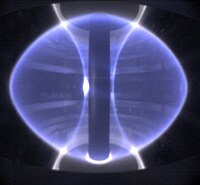
Photo from wikipedia
The National Spherical Torus eXperiment (NSTX) has undergone a major upgrade to NSTX-U at Princeton Plasma Physics Laboratory (PPPL). NSTX-U will double the toroidal field, plasma current, and neutral beam… Click to show full abstract
The National Spherical Torus eXperiment (NSTX) has undergone a major upgrade to NSTX-U at Princeton Plasma Physics Laboratory (PPPL). NSTX-U will double the toroidal field, plasma current, and neutral beam injection heating power, as well as significantly increase the pulse duration. Control of the influx of impurity gases and fuel recycling from plasma facing components (PFCs) are critical for further improving NSTX-U plasma performance. To achieve high quality plasmas during operations, wall conditioning technologies are needed to limit impurities in the plasma by removing the impurities from PFCs before plasma operation, and reducing recycling and outgassing during discharges via reactive coating materials. In this article, the design of a bakeout system, a glow discharge cleaning (GDC) system, a deuterated trimethylboron (dTMB) boron coating system, and a lithium evaporation (LITER) coating system for NSTX-U will be briefly described. Designed for enhanced operational safety, fully automated process control, and easy equipment maintenance and serviceability, these systems have been successfully used to condition the PFCs for NSTX and NSTX-U. Operational sequence and procedure of using these wall conditioning methods for NSTX-U will be covered in this article. Wall conditioning results will also be briefly discussed at the end of this article.
Journal Title: IEEE Transactions on Plasma Science
Year Published: 2020
Link to full text (if available)
Share on Social Media: Sign Up to like & get
recommendations!